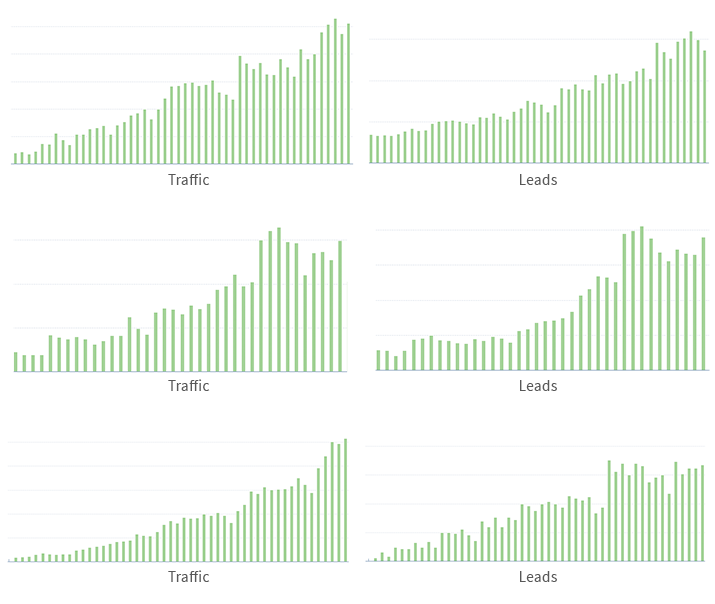
In the 13 years since my business partner Jon and I started our agency, the marketing analytics landscape has changed dramatically.
We’ve watched:
- Google Analytics evolve from its infancy into a mature, sophisticated tool
- The rise Hubspot and a world of person-based, full-funnel measurement tools
- The emergence of heat mapping software like Hotjar and Lucky Orange
- And the birth of marketing AI and machine learning
A lot of good has come from the accessibility of all this incredibly powerful data – from creating accountability for marketers to understanding the ROI of both campaigns and specific tactical deployments.
But this ROI-driven marketing culture hasn’t come without its share of side effects too.
What we sacrifice when we think too short term
In this era where everything is measurable, we tend to make marketing decisions that favor caution over creativity and instant gratification over patience.
In other words, we become more inclined to do only the things that will pay off in a quantifiable way, and quickly.
In particular, I see neglect occurring in three areas:
- The things we do persistently to grow results over the long term
- The investments we make to build brand equity
- The experiments we run that have potential to yield significant results
I’d like to be very clear that this article is not an excuse for pushing accountability to the side. Not at all. Instead, I wrote this as a reminder about what’s sometimes lost in an era consumed both by data overload and a “results now” mentality.
So we’ll do a couple things here.
First, we’ll take a closer look at these three things you may be in danger of neglecting. And second, we’ll conclude with recommendations about how to create the right balance in your marketing strategy.
Area of Neglect #1: Builders of Long-Term Results
Countless people will enter the new year with resolutions to get in better shape – to lose weight, lower blood pressure and generally feel healthier. But to expect a noticeable difference by the end of January (after replacing cheeseburgers with salads and hitting the gym a few times per week) would be unrealistic.
Results require both time and persistence.
The same applies to a number of the most important things we do on the marketing front. Particularly with our inbound activities, results rarely materialize overnight.
The following graphics are real inbound marketing results curves from three different clients of ours. On the left is traffic from organic search. On the right are the resulting leads generated from that traffic.

Notice the similarity in these three examples.
And consider the missed payoff had these organizations quit after six or twelve months because “the results just weren’t there”.
Instead, each client exercised persistence.
They deployed smart SEO strategies, backed by resourceful thought-leadership content – establishing expertise in front of prospects and search engines alike.
One of my greatest lessons learned over the past few years as a marketer (and agency owner) is to properly set expectations. These builders of long-term results are so important and can’t be neglected. But expectations about the role they play and the runway to results need to be appropriately set.
Area of Neglect #2: Builders of Brand Equity
Some of the marketing decisions we make will never lead to a result we can hold in our hands.
That may be tough to stomach, but think about the power of consumer-facing brands like Coca-Cola, Ford, Nike or Apple. Or in the industrial B2B world, household names like Rockwell Automation, FANUC, Grainger or Siemens.
It’s hard to imagine building a powerful trademark on the back of a pay-per-click campaign.
Of course these brands would never be great without a history of exceptional products and services to begin with. But they take their outward appearance very seriously too.
Consider the things you do at a personal level to present yourself professionally – in front of customers, in job interviews or at industry events. You iron your clothes, speak professionally, shake hands firmly and so on.
Great industrial brands do these things too. Their marketing and sales communications are clear and well positioned. Their websites are buttoned up. They proactively take thought leader positions by conducting and publishing industry research reports, guest authoring in trade journals and speaking at events.
These things aren’t always directly measurable. But we know they matter. So we do them.
Area of Neglect #3: The Experiments
The third place we’ll sacrifice when we overvalue short-term results are in the measured risks we may never be willing to take.
In other words – trying new things.
We let our Strategists use Gorilla as a playground to experiment with new marketing technologies and methodologies. Many will fall flat. But some will win big. And we’d never uncover those big wins if we just kept doing the same thing month after month and year after year.
Back in 2012 or so, we experimented with Hubspot (and marketing automation) for Gorilla. This was an almost immediate big win and we subsequently rolled out the software for a number of our clients.
Around the same time, we did the same with methodologies like gating content and guest authoring in industry journals.
More recently, we’ve run experiments with various account-based marketing strategies, paid social and surrounding technologies.
Just as you balance your investment portfolio with safe, steady performers and low-floor, high-ceiling risks, you should allow flexibility to do the same in your marketing initiatives.
Creating the optimal balance
Though I don’t have a canned formula for you, here’s a starter template for balancing producers of short term results, builders of long-term results, builders of brand equity and experiments:

Start here and adjust as you see fit. But do your best to allow for some of each.
There’s nothing wrong with short-term thinking (we all need to pay the bills). Just keep a clear perspective on the bigger picture too.